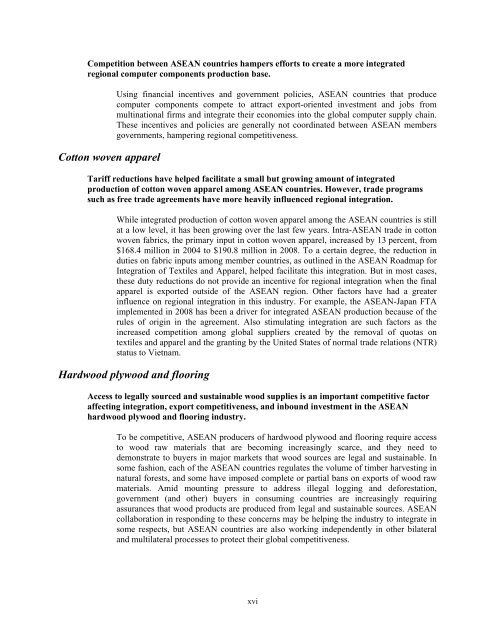ASEAN: Regional Trends in Economic Integration, Export ... - USITC
ASEAN: Regional Trends in Economic Integration, Export ... - USITC
ASEAN: Regional Trends in Economic Integration, Export ... - USITC
You also want an ePaper? Increase the reach of your titles
YUMPU automatically turns print PDFs into web optimized ePapers that Google loves.
Competition between <strong>ASEAN</strong> countries hampers efforts to create a more <strong>in</strong>tegrated<br />
regional computer components production base.<br />
Cotton woven apparel<br />
Us<strong>in</strong>g f<strong>in</strong>ancial <strong>in</strong>centives and government policies, <strong>ASEAN</strong> countries that produce<br />
computer components compete to attract export-oriented <strong>in</strong>vestment and jobs from<br />
mult<strong>in</strong>ational firms and <strong>in</strong>tegrate their economies <strong>in</strong>to the global computer supply cha<strong>in</strong>.<br />
These <strong>in</strong>centives and policies are generally not coord<strong>in</strong>ated between <strong>ASEAN</strong> members<br />
governments, hamper<strong>in</strong>g regional competitiveness.<br />
Tariff reductions have helped facilitate a small but grow<strong>in</strong>g amount of <strong>in</strong>tegrated<br />
production of cotton woven apparel among <strong>ASEAN</strong> countries. However, trade programs<br />
such as free trade agreements have more heavily <strong>in</strong>fluenced regional <strong>in</strong>tegration.<br />
While <strong>in</strong>tegrated production of cotton woven apparel among the <strong>ASEAN</strong> countries is still<br />
at a low level, it has been grow<strong>in</strong>g over the last few years. Intra-<strong>ASEAN</strong> trade <strong>in</strong> cotton<br />
woven fabrics, the primary <strong>in</strong>put <strong>in</strong> cotton woven apparel, <strong>in</strong>creased by 13 percent, from<br />
$168.4 million <strong>in</strong> 2004 to $190.8 million <strong>in</strong> 2008. To a certa<strong>in</strong> degree, the reduction <strong>in</strong><br />
duties on fabric <strong>in</strong>puts among member countries, as outl<strong>in</strong>ed <strong>in</strong> the <strong>ASEAN</strong> Roadmap for<br />
<strong>Integration</strong> of Textiles and Apparel, helped facilitate this <strong>in</strong>tegration. But <strong>in</strong> most cases,<br />
these duty reductions do not provide an <strong>in</strong>centive for regional <strong>in</strong>tegration when the f<strong>in</strong>al<br />
apparel is exported outside of the <strong>ASEAN</strong> region. Other factors have had a greater<br />
<strong>in</strong>fluence on regional <strong>in</strong>tegration <strong>in</strong> this <strong>in</strong>dustry. For example, the <strong>ASEAN</strong>-Japan FTA<br />
implemented <strong>in</strong> 2008 has been a driver for <strong>in</strong>tegrated <strong>ASEAN</strong> production because of the<br />
rules of orig<strong>in</strong> <strong>in</strong> the agreement. Also stimulat<strong>in</strong>g <strong>in</strong>tegration are such factors as the<br />
<strong>in</strong>creased competition among global suppliers created by the removal of quotas on<br />
textiles and apparel and the grant<strong>in</strong>g by the United States of normal trade relations (NTR)<br />
status to Vietnam.<br />
Hardwood plywood and floor<strong>in</strong>g<br />
Access to legally sourced and susta<strong>in</strong>able wood supplies is an important competitive factor<br />
affect<strong>in</strong>g <strong>in</strong>tegration, export competitiveness, and <strong>in</strong>bound <strong>in</strong>vestment <strong>in</strong> the <strong>ASEAN</strong><br />
hardwood plywood and floor<strong>in</strong>g <strong>in</strong>dustry.<br />
To be competitive, <strong>ASEAN</strong> producers of hardwood plywood and floor<strong>in</strong>g require access<br />
to wood raw materials that are becom<strong>in</strong>g <strong>in</strong>creas<strong>in</strong>gly scarce, and they need to<br />
demonstrate to buyers <strong>in</strong> major markets that wood sources are legal and susta<strong>in</strong>able. In<br />
some fashion, each of the <strong>ASEAN</strong> countries regulates the volume of timber harvest<strong>in</strong>g <strong>in</strong><br />
natural forests, and some have imposed complete or partial bans on exports of wood raw<br />
materials. Amid mount<strong>in</strong>g pressure to address illegal logg<strong>in</strong>g and deforestation,<br />
government (and other) buyers <strong>in</strong> consum<strong>in</strong>g countries are <strong>in</strong>creas<strong>in</strong>gly requir<strong>in</strong>g<br />
assurances that wood products are produced from legal and susta<strong>in</strong>able sources. <strong>ASEAN</strong><br />
collaboration <strong>in</strong> respond<strong>in</strong>g to these concerns may be help<strong>in</strong>g the <strong>in</strong>dustry to <strong>in</strong>tegrate <strong>in</strong><br />
some respects, but <strong>ASEAN</strong> countries are also work<strong>in</strong>g <strong>in</strong>dependently <strong>in</strong> other bilateral<br />
and multilateral processes to protect their global competitiveness.<br />
xvi

















